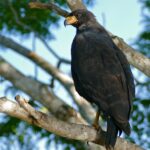The Great Black Hawk (Buteogallus urubitinga) is a magnificent bird of prey found in the tropical regions of the New World, from Mexico to Argentina. As a top predator, this raptor’s diet plays a crucial role in the ecosystem it inhabits. In this comprehensive blog post, we’ll delve into the diverse feeding habits of the Great Black Hawk, exploring the various prey it targets and the unique adaptations that enable it to thrive in its environment.
The Great Black Hawk’s Dietary Preferences
The Great Black Hawk is known for its versatile and opportunistic feeding habits. Its diet primarily consists of:
- Reptiles: This raptor is particularly fond of snakes, lizards, and small crocodilians, which it often hunts on the ground.
- Small Vertebrates: The Great Black Hawk also preys on small mammals, birds, and amphibians, such as frogs and toads.
- Fish: Along the Amazon River and other waterways, the Great Black Hawk has been observed hunting for fish, using its sharp talons to catch its aquatic prey.
- Invertebrates: Large insects, such as beetles, grasshoppers, and crabs, are also part of the Great Black Hawk’s diverse diet.
Hunting Strategies and Adaptations
 Image source: Great Black Hawk by Bernard DUPONT
Image source: Great Black Hawk by Bernard DUPONT
The Great Black Hawk’s hunting strategies are well-suited to its diverse prey. Its broad wings and powerful talons allow it to soar effortlessly, scanning the ground and water for potential targets. When it spots its prey, the Great Black Hawk will swoop down and use its sharp beak and talons to capture and kill its quarry.
One of the Great Black Hawk’s unique adaptations is its ability to hunt on foot. This raptor is known to walk along the ground, using its keen eyesight and hearing to locate and pounce on small reptiles, amphibians, and insects. This ground-based hunting technique allows the Great Black Hawk to access prey that may be hidden in dense vegetation or difficult to spot from the air.
Feeding Behavior and Nesting Habits
The Great Black Hawk is a solitary hunter, often perching on high vantage points to survey its territory. When it spots prey, it will either swoop down from its perch or take flight to pursue its target. Once the prey is captured, the Great Black Hawk will tear it apart with its beak and talons to consume it.
During the breeding season, the Great Black Hawk builds large stick nests high up in trees, often near water sources. The female lays 1-3 eggs, which both parents take turns incubating. Once the chicks hatch, the parents will bring a variety of prey to the nest to feed their young, ensuring they have a diverse and nutritious diet.
Conservation Efforts and Threats
The Great Black Hawk is not currently considered a threatened species, but it faces several challenges in its natural habitat. Deforestation, habitat loss, and human-wildlife conflict can all impact the Great Black Hawk’s population. Conservation efforts, such as protecting the bird’s nesting sites and promoting sustainable land management practices, are crucial to ensuring the long-term survival of this magnificent raptor.
In conclusion, the Great Black Hawk’s diverse diet and hunting strategies are a testament to its adaptability and role as a top predator in its ecosystem. By understanding the feeding habits and ecological importance of this majestic bird, we can better appreciate the intricate web of life that sustains our natural world.
References:
- Great Black Hawk | The Peregrine Fund. Retrieved from https://peregrinefund.org/hawks/great-black-hawk
- Great Black Hawk – Buteogallus urubitinga – Carnivora. Retrieved from https://carnivora.net/great-black-hawk-buteogallus-urubitinga-t5726.html
- Great black hawk – Facts, Diet, Habitat & Pictures on Animalia.bio. Retrieved from https://animalia.bio/great-black-hawk
- Great black hawk – Wikipedia. Retrieved from https://en.wikipedia.org/wiki/Great_black_hawk


